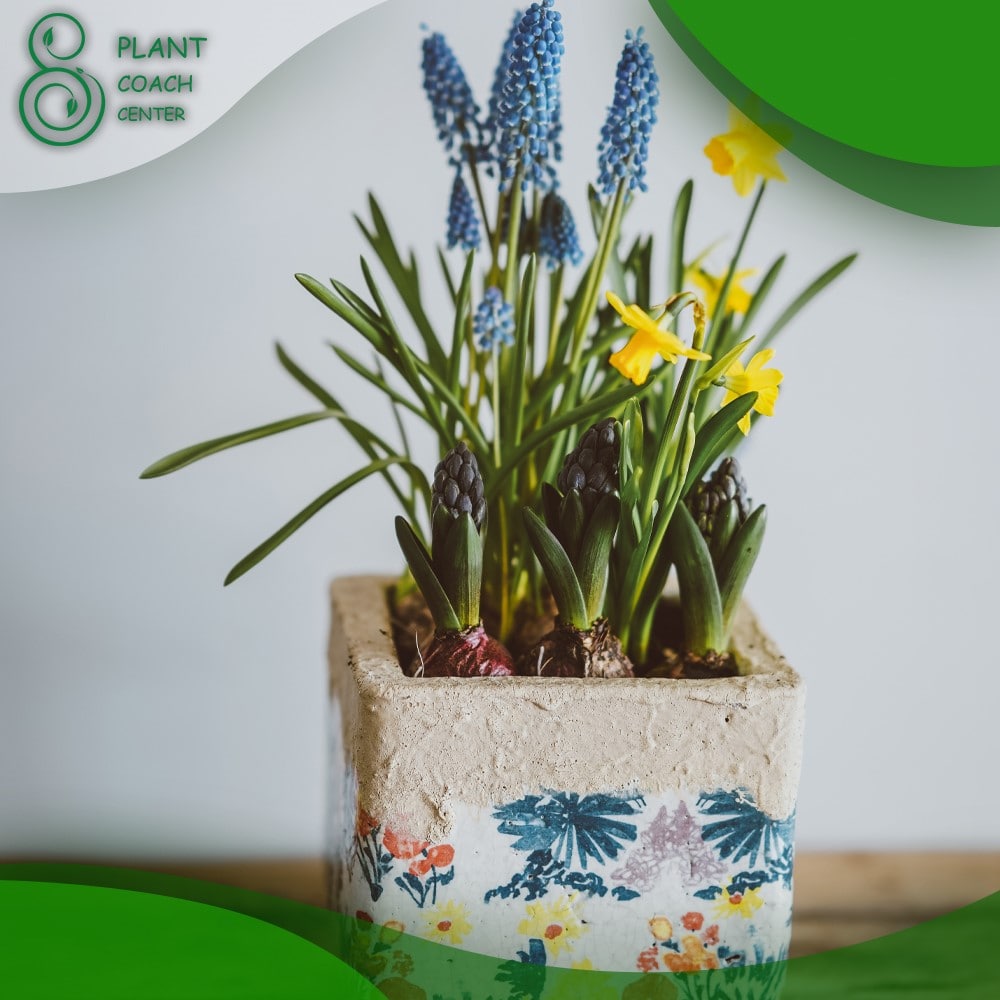When to Plant Hyacinth Bulbs in Pots
Plant coaching is a valuable resource for gardeners seeking guidance and expertise in their plant-related endeavors. In this comprehensive guide, we will delve into the world of hyacinth bulbs and explore the optimal timing and techniques for planting them in pots. Whether you’re a beginner or a seasoned gardener, this article will provide you with the knowledge and insights to successfully grow hyacinth bulbs and enjoy their vibrant blooms.
At PlantCoachCenter.com, you can find a wealth of information and resources to support your gardening journey and learn from experienced plant coaches. Now, let’s dive into the fascinating world of hyacinth bulbs and uncover the secrets to planting them in pots.
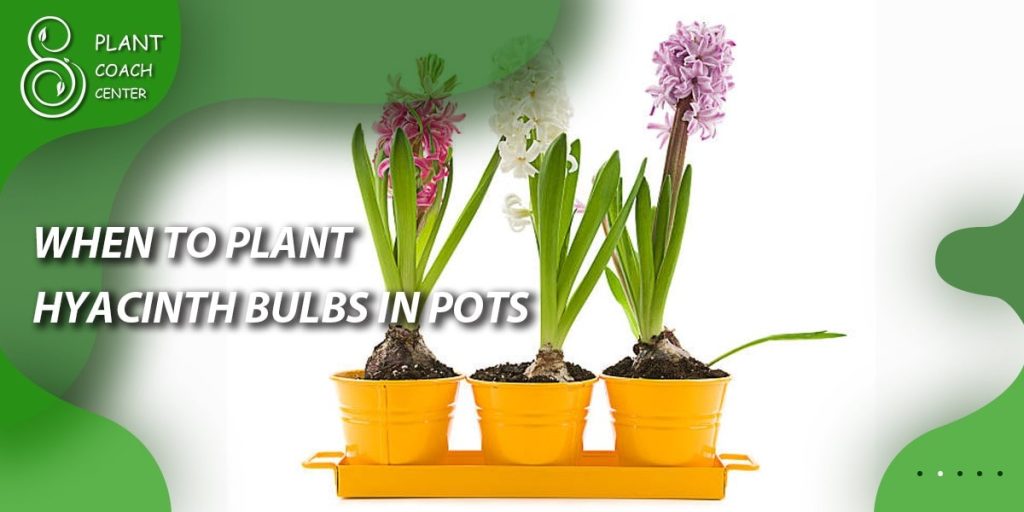
Understanding Hyacinth Bulbs
Hyacinth bulbs, known for their showy and fragrant flowers, belong to the Hyacinthus genus. These perennial bulbs are native to the eastern Mediterranean region and come in a variety of colors, including shades of purple, pink, blue, and white. Understanding the anatomy and growth cycle of hyacinth bulbs will help us make informed decisions when planting them in pots.
Anatomy and Growth Cycle of Hyacinth Bulbs
Hyacinth bulbs consist of several layers, each playing a vital role in the plant’s growth and development:
- Outer Tunic: The dry, papery layer protects the bulb and helps retain moisture.
- Scales: Inner layers composed of fleshy scales store nutrients for the plant.
- Basal Plate: The bottom of the bulb where roots emerge and anchor the plant.
The growth cycle of hyacinth bulbs can be divided into three main stages:
- Dormancy: During winter, hyacinth bulbs enter a period of dormancy, where they require cool temperatures to initiate flower development.
- Vegetative Growth: As temperatures rise in spring, the bulbs sprout leaves and develop a strong root system.
- Flowering: In late spring or early summer, hyacinth bulbs produce tall flower spikes adorned with colorful, fragrant blooms.
Different Varieties of Hyacinth Bulbs
Hyacinth bulbs come in a wide range of cultivars, each offering unique colors, flower forms, and fragrances. Here are some popular varieties to consider:
– ‘Blue Jacket’: A deep blue hyacinth with a strong fragrance.
– ‘Pink Pearl’: Delicate, pink flowers with a sweet scent.
– ‘White Festival’: Pure white blooms that emit a captivating fragrance.
– ‘Woodstock’: Rich, dark purple flowers that add drama to any garden.
Popular Uses and Benefits of Hyacinth Bulbs
Hyacinth bulbs offer numerous benefits beyond their aesthetic appeal. Here are some popular uses and advantages of incorporating hyacinths in your garden:
- Ornamental Beauty: Hyacinths add vibrant colors and delightful fragrance to gardens, containers, and floral arrangements.
- Pollinator Attraction: The nectar-rich flowers attract bees, butterflies, and other pollinators, promoting a healthy ecosystem.
- Indoor Décor: Potted hyacinth bulbs can be forced to bloom indoors, brightening up your home during the winter months.
- Fragrance Therapy: The sweet scent of hyacinths has a calming effect and can enhance your mood and well-being.
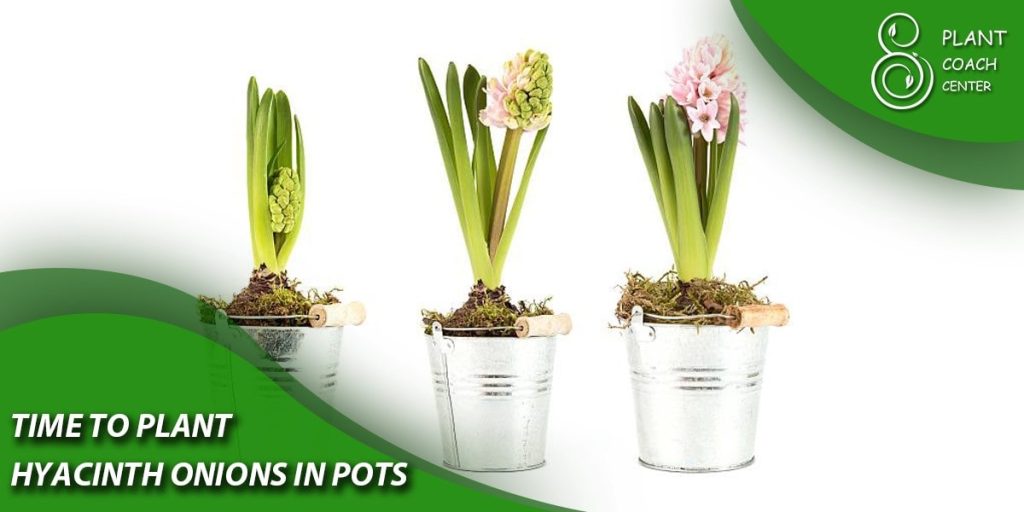
Factors Influencing Planting Time for Hyacinth Bulbs in Pots
When planting hyacinth bulbs in pots, several factors come into play to determine the optimal timing. Let’s examine these factors to ensure successful growth and abundant blooms.
Climate Considerations
Understanding your local climate is crucial when determining the best time to plant hyacinth bulbs in pots. Consider the following climate-related factors:
– Frost Dates: Hyacinth bulbs should be planted in pots after the risk of frost has passed in your area. Frost can damage or kill the tender young shoots.
– Temperature Range: Hyacinths thrive in cool to moderate climates. They require a period of cold dormancy to ensure proper flower development.
– Seasonal Rainfall: Adequate moisture is essential for bulb growth. Consider the rainfall patterns in your region and plan your planting accordingly.
Hardiness Zones and Regional Adaptability
Consult the USDA Hardiness Zone map or a similar resource to determine your specific hardiness zone. Different hyacinth bulb varieties have varying cold hardiness levels and adaptability to particular regions. Choose bulbs that are suitable for your zone for optimal results.
Soil and Light Requirements for Hyacinth Bulbs
Hyacinths prefer well-draining soil with a slightly acidic to neutral pH level. Here are some considerations regarding soil and light conditions:
– Soil Composition: Hyacinths thrive in loamy soil enriched with organic matter. Ensure good drainage to prevent bulb rot.
– Sunlight Exposure: Hyacinth bulbs require full sun to partial shade exposure for healthy growth and abundant blooms. Aim for at least six hours of direct sunlight per day.
Now that we have a better understanding of the factors influencing planting time, let’s move on to preparing pots for planting hyacinth bulbs.
Preparing Pots for Planting Hyacinth Bulbs
Choosing the right pot size and material, along with providing appropriate potting mix, are essential for the successful growth of hyacinth bulbs. Follow these guidelines for optimal pot preparation:
Selecting the Right Pot Size and Material
– Pot Size: Choose pots that allow ample space for the bulb’s root system to develop. A depth of 6-8 inches (15-20 cm) is generally suitable.
– Material: Opt for high-quality pots made from materials such as terracotta, plastic, or ceramic. Ensure the pots have drainage holes at the bottom to prevent waterlogging.
Choosing the Appropriate Potting Mix
– Well-Draining Mix: Use a well-draining potting mix specifically formulated for bulbs or create your own mix by combining equal parts of compost, peat moss, and perlite or vermiculite.
– Nutrient-Rich Blend: Incorporate a slow-release bulb fertilizer into the potting mix to provide essential nutrients for the hyacinth bulbs throughout their growth.
Preparing the Potting Mix for Optimal Drainage and Fertility
– Soil Amendments: If your potting mix is heavy or clayey, add organic matter such as compost or well-rotted manure to improve drainage and fertility.
– Vermiculite or Perlite: Incorporate vermiculite or perlite into the potting mix to enhance its drainage capabilities.
– Pre-Moistening: Before planting, moisten the potting mix to a slightly damp consistency, ensuring it is evenly moist but not waterlogged.
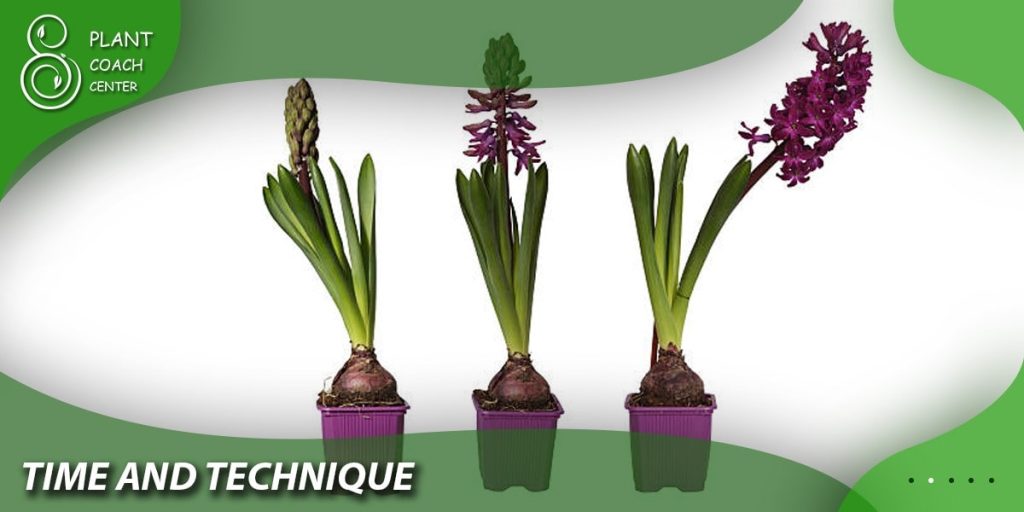
Timing and Techniques for Planting Hyacinth Bulbs in Pots
Proper timing and techniques are crucial for successful establishment and blooming of hyacinth bulbs in pots. Let’s explore the optimal timing and step-by-step instructions for planting hyacinth bulbs.
Determining the Ideal Planting Time
– Late Summer to Early Autumn: The ideal time to plant hyacinth bulbs in pots is typically in late summer or early autumn, about 8-10 weeks before the first expected frost in your area.
– Cool Soil Temperature: Aim for a soil temperature of around 50-60°F (10-15°C) for proper bulb development. Cooler temperatures encourage root growth before the onset of winter.
Preparing Bulbs for Planting
– Inspecting and Selecting Bulbs: Carefully inspect the bulbs, discarding any damaged or diseased ones. Choose firm, plump bulbs with no signs of rot or mold.
– Pre-Chilling (Optional): Some gardeners recommend pre-chilling hyacinth bulbs in the refrigerator for 6-8 weeks before planting. This mimics the natural cold dormancy period and can promote better blooms.
Steps for Planting Hyacinth Bulbs in Pots
- Fill the prepared pots with the moistened potting mix, leaving about an inch (2.5 cm) of space below the rim.
- Dig a hole in the center of the pot, deep enough to accommodate the bulb with its pointed end facing upward.
- Place the bulb in the hole, ensuring it sits at a depth of approximately twice its own height.
- Gently backfill the hole with the potting mix, firming it around the bulb to eliminate air pockets.
- Repeat the process for additional bulbs, spacing them 2-3 inches (5-7.5 cm) apart within the pot.
- Water the pots thoroughly after planting to settle the soil and initiate bulb growth.
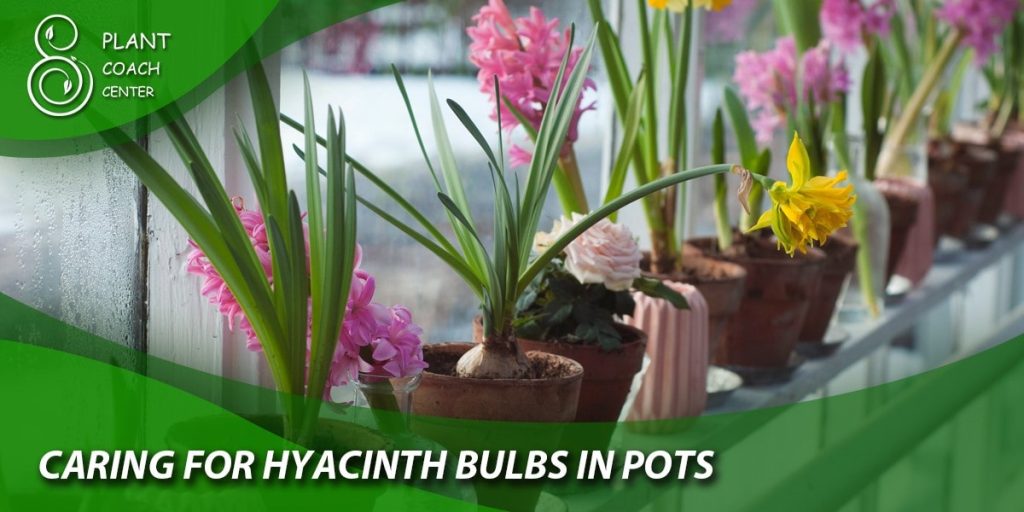
Caring for Hyacinth Bulbs in Pots
Proper care is essential for the healthy growth and development of hyacinth bulbs in pots. Pay attention to watering, fertilizing, sunlight, and pest management.
Watering and Moisture Management
– Moderate Moisture: Hyacinth bulbs prefer consistently moist soil but not waterlogged conditions. Water the pots when the top inch (2.5 cm) of soil feels dry, providing enough water to thoroughly moisten the root zone.
– Avoid Overwatering: Excess moisture can lead to bulb rot. Ensure proper drainage and avoid allowing the pots to sit in water-filled saucers.
Fertilizing and Nutrient Requirements
– Pre-Planting Fertilization: Incorporate a slow-release bulb fertilizer into the potting mix during preparation.
– Mid-Season Fertilization: Once shoots emerge, provide a balanced liquid fertilizer diluted to half strength every 2-3 weeks to support healthy growth and flower development.
Providing Adequate Sunlight and Temperature Conditions
– Sunlight Exposure: Place the pots in a location that receives full sun to partial shade, ensuring they get at least 6 hours of direct sunlight per day.
– Temperature Considerations: Hyacinth bulbs thrive in cool to moderate temperatures, ideally between 60-65°F (15-18°C). Avoid exposing them to extreme heat or cold.
Managing Pests and Diseases
– Common Pests: Watch out for pests like aphids, slugs, and snails. Use appropriate organic pest control methods or consult with a plant coach for effective solutions.
– Disease Prevention: Ensure good air circulation around the pots and avoid overwatering to reduce the risk of fungal diseases.
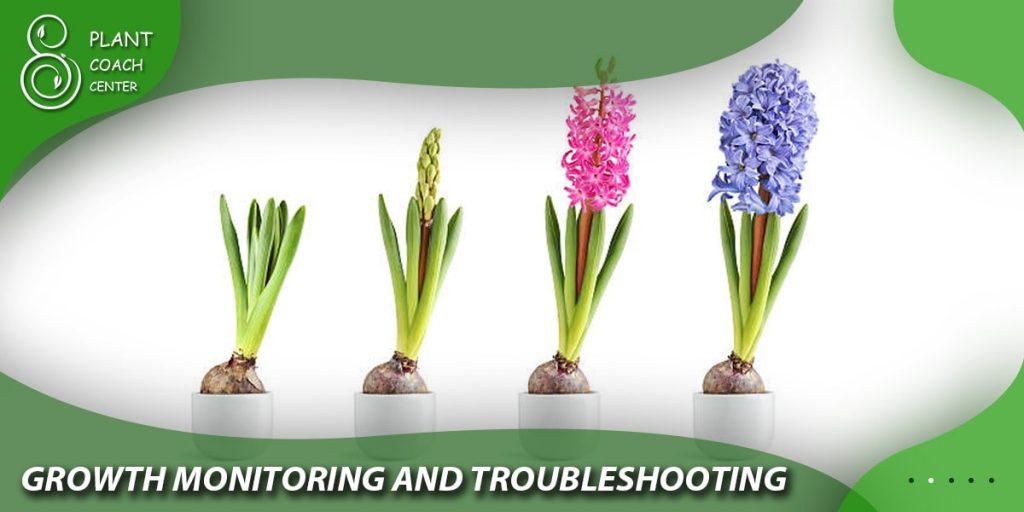
Monitoring Growth and Troubleshooting Common Issues
Monitoring the growth of your hyacinth bulbs in pots is essential to ensure their well-being and address any issues promptly. Here are some key aspects to monitor and common issues to watch out for:
Monitoring Growth and Development
– Shoot Emergence: Within a few weeks of planting, you should start to see the emergence of green shoots from the bulbs.
– Root Development: Check the pots periodically to ensure healthy root growth. Gently lift the bulbs to inspect the root system without causing damage.
– Flower Spike Formation: As the plants mature, flower spikes will develop. Monitor their progress and anticipate the arrival of blooms.
Common Issues and Troubleshooting
– Stunted Growth or No Blooms: Inadequate chilling period, incorrect planting depth, or insufficient sunlight can lead to stunted growth or lack of blooms. Ensure you’ve provided the bulbs with the necessary cold period and proper planting conditions.
– Yellowing Leaves: Yellowing leaves may indicate overwatering, nutrient deficiencies, or pest infestation. Adjust watering practices and provide appropriate fertilization.
– Pest Infestation: Keep an eye out for aphids, slugs, snails, or other pests that may attack the foliage or flowers. Employ appropriate pest control methods or seek advice from a plant coach.
– Fungal Diseases: Excessive moisture or poor air circulation can lead to fungal diseases like bulb rot or leaf blight. Ensure proper drainage, avoid overwatering, and provide adequate spacing between pots to promote airflow.
Enjoying the Fruits of Your Labor
With proper care and attention, your hyacinth bulbs will reward you with spectacular blooms and enchanting fragrance. Once the flowers have reached their peak, you can enjoy them in various ways:
– Outdoor Beauty: Adorn your garden, patio, or balcony with pots of blooming hyacinths, creating colorful focal points and adding fragrance to your outdoor space.
– Indoor Elegance: Cut some hyacinth blooms and create beautiful floral arrangements to enhance the ambiance of your home. Their fragrance will fill the room with a delightful scent.
– Gift Giving: Share the beauty of hyacinths with friends or loved ones by gifting potted hyacinth bulbs or bouquets. They make charming gifts for any occasion.
Conclusion: Cultivating Hyacinth Bulbs in Pots with Plant Coaching
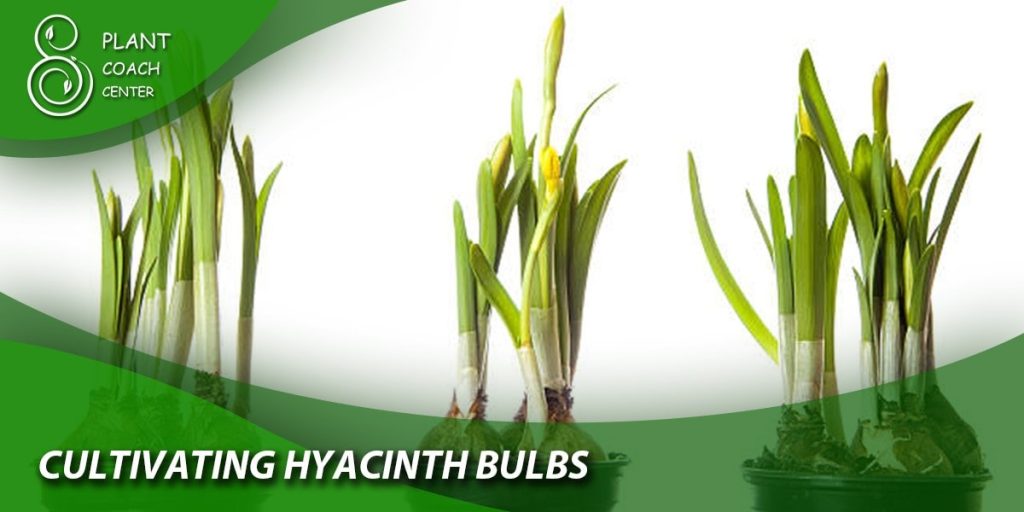
Growing hyacinth bulbs in pots is a rewarding endeavor that brings natural beauty and fragrance to your surroundings. By following the guidance provided in this comprehensive guide, you can ensure successful growth and enjoy the vibrant blooms of hyacinths.
Remember, at PlantCoachCenter.com, you can find a wealth of information and resources to support your gardening journey. The expertise of plant coaches is invaluable in assisting you through every step of the process, from selecting the right bulbs to troubleshooting issues that may arise.
So, grab your pots, select your favorite hyacinth bulbs, and embark on a journey of creating a stunning display of these beloved spring flowers. With proper care and the guidance of plant coaching, you’ll experience the joy and satisfaction of cultivating hyacinth bulbs in pots, turning your gardening dreams into a fragrant reality.
When should I plant hyacinth bulbs in pots?
Fall.
Can I plant hyacinth bulbs in pots during spring?
No.
What is the ideal time to plant hyacinth bulbs in pots?
Late September to early November.
Can I plant hyacinth bulbs in pots during summer?
It is not recommended.


